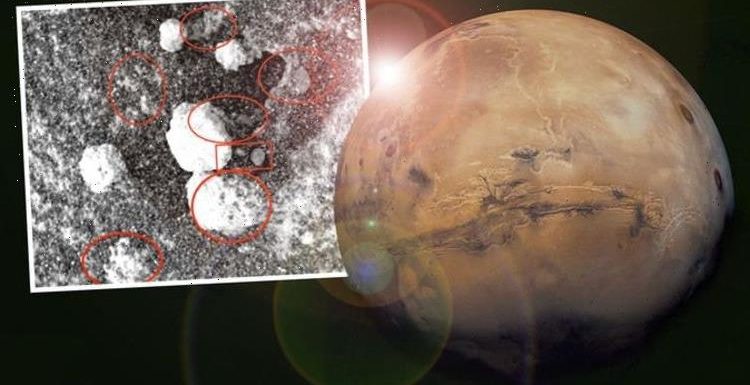
Mars: ‘Absolutely’ there is life on red planet says expert
We use your sign-up to provide content in ways you’ve consented to and to improve our understanding of you. This may include adverts from us and 3rd parties based on our understanding. You can unsubscribe at any time. More info
The hunt for life on Mars is on with multiple rovers and orbiting spacecraft scanning the Red Planet for biosignatures of life. Leading the pack is NASA’s Perseverance rover, which has been collecting and analysing rock samples for past alien life since February this year. But scientists are also playing their part here on Earth, with one researcher, in particular, exposing what he believes is evidence of ET activity.
In a recent paper published in the Journal of Astrobiology, fringe researcher Dr Rhawn Gabriel Joseph claims to found proof life once evolved on Mars and may still exist there today.
His claims follow the discovery of tube-like structures in the soil and rocks of Endurance Crater in the Meridiani Planum region – an ancient impact crater explored by NASA’s Opportunity rover in 2004.
Citing photos snapped by the NASA mission, Dr Joseph claimed these tubular features bear a striking resemblance to critters found on Earth.
More specifically, he claims to have found “biological” evidence of Martian tube worms resembling marine creatures found on Earth at the bottom of the Pacific and near hydrothermal vents.
These Martian tubes measure up to 3mm in size and are barely discernable from rocks in the provided images.


The report reads: “In addition, shrimp-shaped and spiral-shaped ‘worms’ and oval-shaped Martian specimens with appendages similar to the pleopods of crustaceans have been observed in close proximity to the tubular structures of Endurance Crater.
“On Earth, crustaceans are often observed in close proximity to tube worm colonies.
“Morphological comparisons with terrestrial tube worms and worm tubes also indicates a close similarity to the Martian tubes and the variety of ‘worms’ photographed on the surface of Endurance Crater.”
These are very questionable claims, however, even though the paper appears to be backed by some serious institutions.
Among the paper’s listed co-authors, there are researchers from the Harvard-Smithsonian Center for Astrophysics, as well as the National Center for Scientific Research in France.
The researchers allege Endurance Crater may have been the perfect melting pot for life to evolve millions of years ago, as it may have once hosted briny water heated by thermal vents.
NASA Perseverance rover: First images and sounds revealed
And that is true – the bone-dry Mars of today once resembled a young Earth, with a thick atmosphere and liquid oceans.
But in the 46 years since NASA’s Viking 1 probe first landed on Mars, scientists are yet to find convincing evidence of alien life on the planet.
And according to some researchers who took a look at Dr Joseph’s paper, this is not the study to finally prove ETs are real.
Known to some as the “Space Tiger King”, Dr Joseph has made a name for himself with his various theories and claims about the Red Planet.
Earlier this year he sparked a great debate about ET life, after he published photographs of what believed were Martian mushrooms.
The scientific community was left unconvinced, however, instead suggesting a more plausible explanation – rocks.
Professor John Womersley from the University of Oxford thinks the latest report is pretty far off the mark as well.

He told Express.co.uk: “The idea of tube worms on Mars is most probably complete b******s.
“However, it’s not impossible that Mars hosted some form of life millions of years ago when its climate was more hospitable, and that life may have left traces on the surface.
“It will take a lot more than looking at pictures taken by Mars rovers and noting similarities to terrestrial life to convince most scientists, though, and that is why NASA and ESA have embarked on an ambitious series of missions to eventually return samples from Mars to Earth for really thorough analysis.
“Until then, we must all be careful not to make wild claims based on over-interpretation of NASA photographs of the surface of Mars.”
The researchers themselves note in their paper, their discoveries do not necessarily prove their assertions with complete certainty.
The report reads: “Similarities in morphology are not proof of life and abiogenic explanations cannot be ruled out.
“Therefore, despite the numerous specimens that resemble ‘tube worms’ and ‘worm tubes it cannot be stated with certainty that tube worms colonized the putative watery-briny environment of Endurance Crater.”
If anyone is going to find evidence of life on Mars, it is likely going to be scientists studying Mars rock samples up close.
NASA’s Perseverance rover is part of a two-stage mission that will see the world’s first rock sample retrieval.
Perseverance will collect and safely store samples for another spacecraft to pick up and launch back to Earth.
If all goes according to plan, NASA hopes to collect at least 20 samples for analysis back on Earth.
Source: Read Full Article